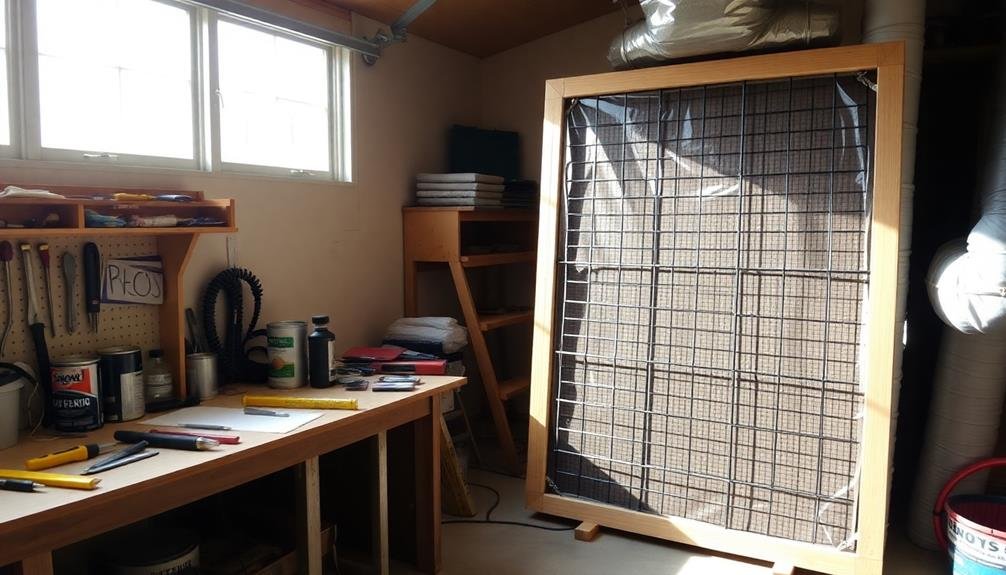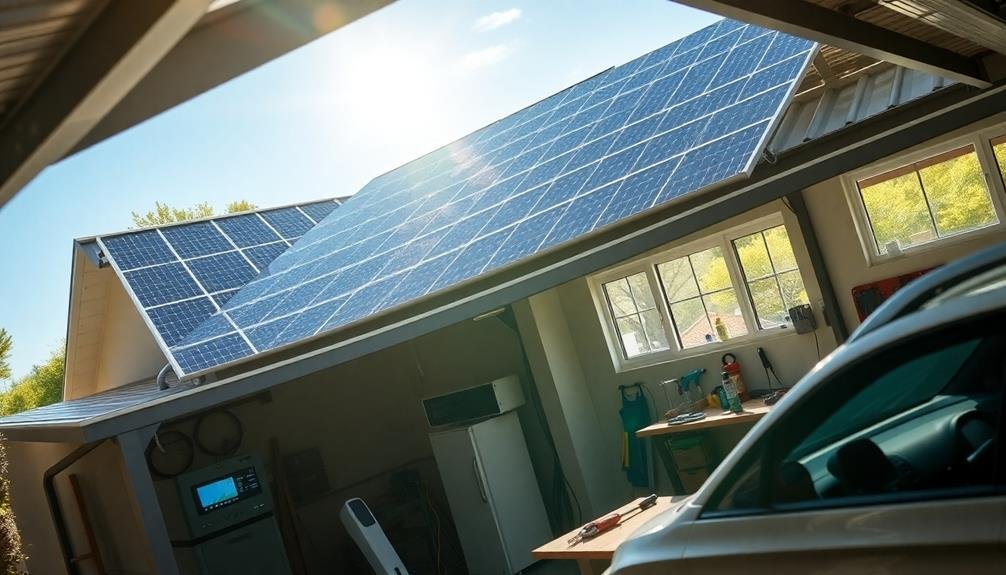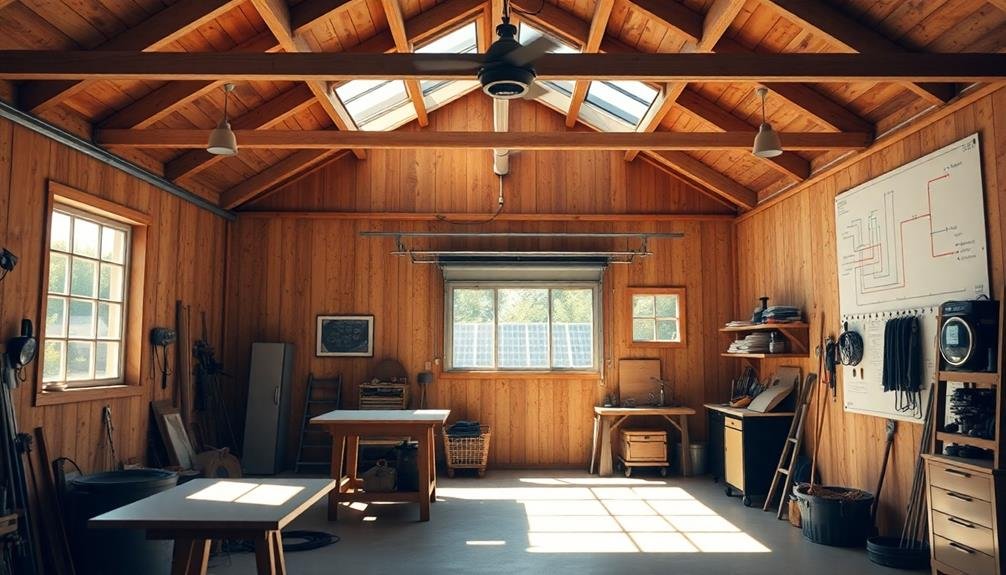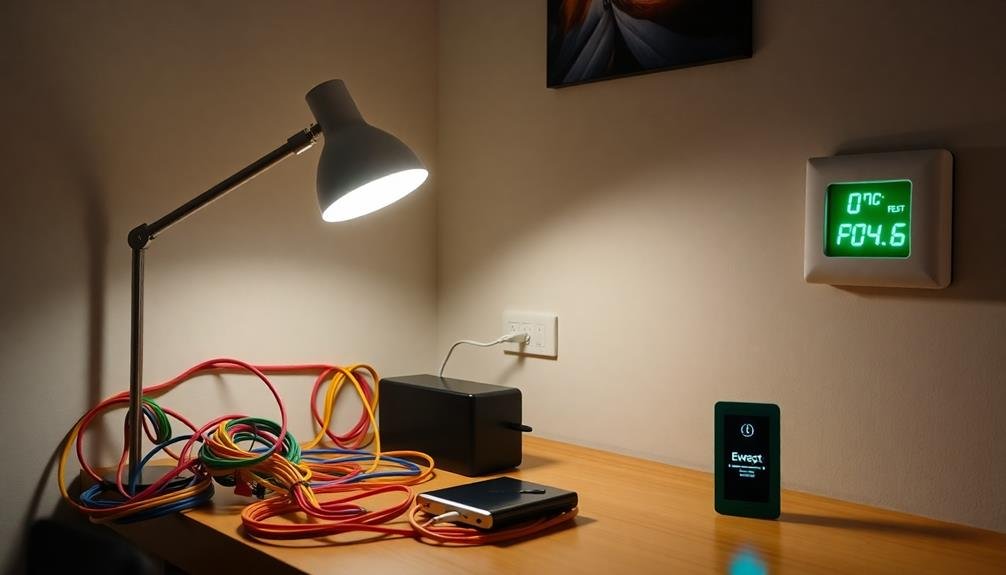You can transform your chilly garage workshop into a warm, comfortable space by harnessing the sun's power with a solar air heating system. These systems use collectors mounted on south-facing surfaces to absorb sunlight and heat air, which is then circulated into your garage. You'll enjoy improved comfort, energy efficiency, and better air quality while reducing your carbon footprint. To get started, assess your garage's solar potential by considering factors like orientation, roof pitch, and local climate. Choose between glazed or unglazed collectors based on your needs and budget. With the right setup, you'll be well on your way to a cozy, sustainable workshop.
Understanding Solar Air Heating Systems

Three key components make up a solar air heating system: collectors, air ducts, and a fan.
Collectors are typically mounted on a south-facing wall or roof, absorbing sunlight and converting it into heat. They're designed with a dark, heat-absorbing surface and a transparent cover to trap warmth.
Air ducts connect the collectors to your garage, allowing heated air to circulate. These ducts should be well-insulated to minimize heat loss during transfer.
The fan, usually installed within the ductwork, moves air through the system, drawing cool air from your garage into the collectors and pushing warm air back in.
You'll find two main types of solar air heaters: glazed and unglazed.
Glazed collectors have a glass or plastic cover, offering better efficiency but at a higher cost. Unglazed collectors are simpler and less expensive, ideal for moderate climates or supplemental heating.
To enhance efficiency, consider factors like collector size, garage insulation, and local climate.
Proper sizing guarantees peak performance, while good insulation helps retain the captured heat. In colder regions, you might need to combine solar heating with a backup system for consistent warmth.
Benefits for Garage Workshops
Solar air heating systems offer numerous advantages for garage workshops. You'll experience improved comfort as these systems maintain a consistent temperature, allowing you to work year-round without freezing in winter or sweating in summer.
They're energy-efficient, reducing your reliance on traditional heating methods and lowering utility bills. This eco-friendly option also decreases your carbon footprint, making your workshop more sustainable.
You'll benefit from better air quality, as solar air heaters constantly circulate and filter the air, reducing dust and fumes common in workshop environments. This improved ventilation can help protect your tools from moisture and rust.
The system's silent operation won't interfere with your work or disturb neighbors, unlike noisy space heaters.
Installation is typically straightforward, often requiring minimal modifications to your existing structure. Once installed, these systems are low-maintenance, saving you time and money on upkeep.
They can also increase your property value, making them a smart long-term investment. With a solar air heating system, you'll create a more comfortable, efficient, and environmentally friendly workspace that enhances your productivity and enjoyment of your garage workshop.
Assessing Your Garage's Solar Potential

Before diving into solar air heating installation, it is vital to evaluate your garage's suitability for this eco-friendly solution. Start by reviewing your garage's orientation and roof pitch. South-facing roofs with a 30-45 degree angle are ideal for maximum sun exposure. Next, examine any potential shading from nearby trees, buildings, or other obstructions that could reduce solar efficiency.
Consider your local climate and average sunny days per year. Regions with more sunlight will naturally benefit more from solar air heating. Analyze your garage's insulation and overall energy efficiency, as a well-insulated space will retain heat better. Finally, check local building codes and regulations to guarantee compliance with solar installations.
| Factor | Impact on Solar Potential |
|---|---|
| Orientation | Vital for sun exposure |
| Roof Pitch | Affects panel efficiency |
| Shading | Can drastically reduce output |
| Climate | Determines overall effectiveness |
| Insulation | Enhances heat retention |
Choosing the Right Collector Type
Once you've determined your garage's solar potential, it's time to select the appropriate solar air collector for your needs. There are two main types to evaluate: glazed and unglazed collectors.
Glazed collectors feature a glass or plastic cover that traps heat, making them more efficient in colder climates. They're ideal for year-round use and can achieve higher temperatures. However, they're more expensive and require professional installation.
Unglazed collectors are simpler and more affordable. They consist of a dark-colored absorber plate without a cover. These work well in milder climates and are perfect for extending your workshop season into spring and fall. You can often install them yourself, saving on costs.
Evaluate your climate, budget, and heating needs when choosing. If you're in a cold area and need significant heat gain, opt for a glazed collector. For moderate climates or supplemental heating, an unglazed collector might suffice.
Don't forget to factor in size. Larger collectors generate more heat but require more space and investment. Calculate your heating requirements to determine the ideal collector size for your garage workshop.
DIY Solar Air Heater Materials

When building your DIY solar air heater, you'll need to gather essential components and tools to guarantee a successful project.
You'll have several options for the collector frame, including wood, metal, or plastic, each with its own advantages.
For the absorber plate, you can choose from materials like aluminum, copper, or even repurposed metal sheets, which will efficiently capture and transfer heat to the air passing through your heater.
Essential Components and Tools
The essential components and tools for building a DIY solar air heater are surprisingly simple and affordable.
You'll need a wooden frame, which serves as the base of your heater. For the collector, opt for a sheet of corrugated metal roofing, painted black to absorb maximum heat. Insulation is vital; choose rigid foam board insulation to line the interior of the frame.
To cover the front of the heater, you'll need a clear polycarbonate sheet or tempered glass. For air circulation, install inlet and outlet vents, along with a small fan to boost airflow. Don't forget to include a thermostat to regulate temperature.
As for tools, you'll need a saw for cutting wood, a drill for making holes, and a staple gun for securing materials. A caulking gun is essential for sealing gaps and ensuring efficiency.
You'll also need basic hand tools like screwdrivers, pliers, and a measuring tape.
To assemble your solar air heater, gather screws, nails, and weatherstripping tape. With these components and tools, you'll be well-equipped to construct an effective solar heating system for your garage workshop.
Collector Frame Options
Building on the foundation of essential components, let's explore your options for the collector frame – a key element of your DIY solar air heater. The frame serves as the backbone of your solar collector, supporting the glazing and housing the absorber plate.
You can construct the frame using various materials, each with its own advantages. Wood is a popular choice due to its affordability and ease of working. Cedar or pressure-treated lumber offers good durability against outdoor conditions.
Alternatively, aluminum extrusions provide a lightweight, corrosion-resistant option that's ideal for long-term use. For a more robust solution, consider using steel or galvanized metal. These materials offer excellent strength and longevity but may require more specialized tools for fabrication.
If you're aiming for a sleek, modern look, extruded PVC or UPVC profiles can be a great choice, offering good insulation properties and resistance to weathering.
When selecting your frame material, consider factors such as local climate, budget, and your DIY skill level. Remember to factor in the weight of the glazing and absorber plate when choosing your frame material to guarantee proper support and longevity for your solar air heater.
Absorber Plate Materials
Heart of your solar air heater, the absorber plate plays a crucial role in capturing and transferring heat. You'll want to choose a material that's both efficient and cost-effective. The most common options include aluminum, copper, and steel.
Aluminum is lightweight, affordable, and conducts heat well. It's easy to work with and won't rust, making it a popular choice for DIY projects. Copper, while more expensive, offers superior heat conductivity. It's durable and will last for years, but it's harder to work with and can be costly. Steel is another option, providing good heat absorption at a lower price point than copper.
To maximize heat absorption, paint your plate with a high-temperature black paint. This will help it capture more solar energy and transfer it to the air passing through your heater.
| Material | Pros | Cons | Efficiency |
|---|---|---|---|
| Aluminum | Lightweight, affordable | Less durable | Good |
| Copper | Excellent conductivity | Expensive, difficult to work with | Excellent |
| Steel | Durable, moderate cost | Heavier, can rust | Good |
| Recycled cans | Very affordable, readily available | Labor-intensive | Moderate |
Consider your budget, skills, and desired efficiency when selecting your absorber plate material. With the right choice, you'll be well on your way to a warm garage workshop.
Step-by-Step Installation Guide
Once you've gathered all the necessary materials and tools, it's time to begin the installation process for your warm garage workshop.
Start by preparing the south-facing wall of your garage, ensuring it's clean and structurally sound. Next, install the mounting brackets for your solar collector, making sure they're level and securely fastened.
Attach the absorber plate to the collector frame, then carefully position the glazing on top. Seal all edges to prevent air leaks and moisture infiltration.
Install the insulation behind the absorber plate to minimize heat loss. Connect the inlet and outlet pipes to your collector, ensuring proper flow direction.
Mount the storage tank in a suitable location, preferably elevated above the collector. Install the circulation pump and connect it to both the collector and storage tank.
Add the heat transfer fluid to the system, following manufacturer guidelines. Install temperature sensors at key points in the system.
Optimizing Airflow in Your Workshop

Ensuring proper airflow in your workshop is essential for maintaining a comfortable and productive environment. Good ventilation helps regulate temperature, remove dust and fumes, and prevent moisture buildup.
To optimize airflow in your garage workshop, consider installing exhaust fans, ceiling fans, or even a whole-house fan. Strategic placement of fans and vents can create a cross-breeze, promoting air circulation throughout the space.
Don't forget to include adjustable openings like windows or vents to control airflow as needed. When designing your workshop layout, keep airflow in mind by avoiding clutter and maintaining clear pathways for air movement.
Here are five tips to improve airflow in your workshop:
- Install a programmable thermostat to automate temperature control
- Use air purifiers to filter out dust and particles
- Create designated work zones with localized ventilation
- Implement a dust collection system for power tools
- Regularly clean and maintain your HVAC system
Integrating With Existing Heating Systems
When integrating your garage workshop's heating with your home's existing system, consider complementary heating solutions that work in tandem with your main heat source.
You'll want to focus on efficient energy distribution to guarantee warmth reaches all areas of your workspace.
Complementary Heating Solutions
Three complementary heating solutions can effectively integrate with your existing garage heating system to boost warmth and efficiency.
Consider adding these options to enhance your workshop's comfort:
- Radiant floor heating
- Infrared heating panels
- Portable space heaters
- Heat recovery ventilation systems
- Thermal curtains or insulated garage doors
Radiant floor heating provides consistent warmth from the ground up, ideal for concrete floors.
Infrared panels offer targeted heat for specific work areas, while portable space heaters give you flexibility to move heat where it's needed most.
Heat recovery ventilation systems improve air quality while conserving energy.
Thermal curtains or insulated garage doors reduce heat loss and drafts.
When integrating these solutions, verify they're compatible with your existing system.
You'll want to balance energy efficiency with heating effectiveness.
Don't forget to factor in your workshop's layout and your typical activities.
By combining complementary heating methods, you'll create a more comfortable and productive workspace year-round.
Remember to follow safety guidelines and local building codes when installing new heating elements in your garage workshop.
Efficient Energy Distribution
To maximize the efficiency of your garage workshop heating system, you'll need to focus on integrating new elements with your existing setup.
Start by evaluating your current heating infrastructure and identifying areas where solar-powered components can complement or replace traditional heating methods.
Consider installing a smart thermostat that can communicate with both your existing heating system and new solar-powered elements. This will allow for seamless coordination between different heat sources, ensuring ideal temperature control and energy usage.
You'll also want to assess your garage's insulation and seal any air leaks to prevent heat loss and improve overall efficiency.
Incorporate a heat distribution system, such as strategically placed fans or a ductwork network, to evenly circulate warm air throughout your workspace. This will help eliminate cold spots and maintain a consistent temperature.
Don't forget to position your workstations and equipment in a way that doesn't obstruct airflow.
Lastly, implement zoning controls to direct heat where it's needed most. This allows you to prioritize heating in specific areas of your garage workshop, reducing energy waste and improving comfort while you work.
Monitoring and Maintaining Performance

Regularly monitoring and maintaining your garage workshop's heating system is essential for peak performance. You'll want to keep a close eye on your system's efficiency and make adjustments as needed.
Implement a routine inspection schedule to catch potential issues early and prevent costly repairs.
To guarantee your heating system operates at peak performance, focus on these key areas:
- Check and clean solar panels regularly
- Inspect insulation for gaps or damage
- Test thermostat accuracy and calibrate if necessary
- Examine ductwork for leaks or obstructions
- Monitor energy consumption patterns
Keep detailed records of your system's performance, including energy production, consumption, and any maintenance performed. This data will help you identify trends and potential problems over time.
Don't forget to clean or replace air filters as recommended by the manufacturer to maintain ideal airflow and efficiency.
If you notice any unusual noises, temperature fluctuations, or a sudden increase in energy bills, investigate promptly. These could be signs of underlying issues that need attention.
Cost Analysis and Energy Savings
You'll need to evaluate both the initial investment and long-term energy savings when heating your garage workshop.
Break down the upfront costs, including insulation, heating equipment, and installation fees, to understand the full financial commitment.
Over time, you'll likely recoup your investment through reduced energy bills and increased comfort in your workspace.
Initial Investment Breakdown
Setting up a warm garage workshop requires a careful consideration of initial costs and potential energy savings. You'll need to break down your investment into key components to guarantee you're making informed decisions. The primary expenses typically include insulation, heating systems, and energy-efficient lighting.
When evaluating your initial investment, consider these vital elements:
- Insulation materials and installation costs
- Heating system purchase and setup
- Energy-efficient LED lighting fixtures
- Weatherstripping and door seals
- Solar panel installation (if applicable)
Your insulation costs will vary depending on the size of your garage and the type of insulation you choose. Spray foam insulation offers excellent protection but comes at a higher price point than fiberglass batts.
For heating, you might opt for a forced-air system, radiant floor heating, or infrared heaters. Each option has its own price range and energy efficiency ratings.
Don't forget to factor in the cost of professional installation if you're not planning a DIY approach. While it may increase your upfront expenses, expert installation can guarantee peak performance and energy savings in the long run.
Long-Term Energy Savings
Investing in a warm garage workshop can lead to substantial long-term energy savings. You'll notice a significant reduction in your energy bills as your solar-powered heating system harnesses free energy from the sun. Over time, these savings will offset your initial investment and continue to benefit your wallet for years to come.
By utilizing solar panels and efficient insulation, you're drastically reducing your reliance on traditional energy sources. This means you'll be less affected by rising utility costs and potential energy shortages. You can expect to save anywhere from 50% to 80% on your heating expenses, depending on your location and system setup.
Additionally, you'll benefit from government incentives and tax credits for using renewable energy sources. These financial perks can further accelerate your return on investment.
Don't forget about the increased property value that comes with an energy-efficient workshop. Potential buyers will appreciate the long-term savings and eco-friendly features, making your property more attractive in the real estate market.
As energy prices continue to climb, your decision to invest in a warm garage workshop will prove increasingly valuable, providing you with a comfortable, cost-effective space for years to come.
Overcoming Common Installation Challenges

Installing a heating system in your garage workshop can present several challenges, but they're not insurmountable.
You'll need to address insulation, ventilation, and proper equipment sizing to guarantee peak performance. Start by evaluating your garage's current condition and identifying areas that need improvement.
Common installation challenges you might face include:
- Inadequate insulation in walls, ceiling, and garage door
- Lack of proper ventilation to prevent moisture buildup
- Insufficient electrical capacity for new heating equipment
- Limited floor space for heating unit placement
- Potential code compliance issues
To overcome these challenges, begin by upgrading your garage's insulation.
Install weatherstripping around doors and windows to prevent heat loss.
Confirm proper ventilation by installing vents or a small exhaust fan.
Consult an electrician to determine if your existing electrical system can handle the new heating load.
If space is limited, consider wall-mounted or ceiling-mounted heaters.
Seasonal Considerations for Maximum Efficiency
To maximize the efficiency of your garage workshop heating system throughout the year, you'll need to adapt your approach for each season.
In spring and fall, focus on using natural ventilation by opening windows and doors during warmer days. This will help regulate temperature and reduce your reliance on heating systems.
During summer, prioritize cooling and ventilation. Install reflective window films to reduce heat gain and use fans to circulate air. Consider adding a portable air conditioner for extreme heat days.
In winter, seal any gaps or cracks to prevent heat loss, and use weather stripping around doors and windows. Insulate your garage door and walls to retain heat more effectively.
Year-round, make use of a programmable thermostat to optimize heating and cooling based on your workshop usage patterns.
Install ceiling fans to help distribute warm air in winter and create a cooling effect in summer. Consider using radiant floor heating for consistent warmth during colder months.
Expanding Your Solar Heating Setup

While adapting your workshop for seasonal changes is important, leveraging solar energy can provide year-round benefits. To expand your solar heating setup, consider incorporating additional solar technologies and maximizing your existing system's efficiency.
Start by evaluating your current setup and identifying areas for improvement. You might want to:
- Install solar air heaters on south-facing walls
- Add a solar water heating system for radiant floor heating
- Implement solar-powered ventilation fans for better air circulation
- Upgrade to more efficient solar panels or increase their number
- Integrate a solar battery storage system for nighttime use
Once you've identified potential upgrades, prioritize based on your budget and needs. Begin with low-cost improvements like sealing air leaks and adding insulation to maximize your current system's effectiveness.
As you expand, verify your electrical system can handle the increased load.
Don't forget to maintain your solar setup regularly. Clean panels, check connections, and monitor performance to keep your system running efficiently.
Frequently Asked Questions
Can Solar Air Heating Systems Be Used in Regions With Frequent Cloudy Weather?
Yes, you can use solar air heating systems in cloudy regions. They'll still collect some solar energy, though less efficiently. You'll need to supplement with backup heating on overcast days. Consider your local climate before investing.
How Noisy Are Solar Air Heaters When Operating in a Garage Workshop?
You'll find solar air heaters are typically very quiet. They don't have moving parts like fans, so they operate silently. You won't notice any noise disruption in your garage workshop while they're working to warm the space.
Do Solar Air Heaters Affect the Resale Value of a Home?
You'll likely see a positive impact on your home's resale value with solar air heaters. They're eco-friendly upgrades that can lower energy costs and appeal to environmentally conscious buyers. However, the exact value increase may vary by location.
Can Solar Air Heating Systems Be Used to Cool Garages in Summer?
You can't use solar air heating systems to cool garages in summer. They're designed to warm air, not cool it. For summer cooling, you'd need a different system like air conditioning or evaporative cooling.
Are There Any Safety Concerns With Using Solar Air Heaters in Workshops?
You'll need to evaluate a few safety concerns with solar air heaters in workshops. Guarantee proper installation, avoid overheating, maintain electrical components, and keep flammable materials away. Always follow manufacturer guidelines and local building codes for safe operation.
In Summary
You've now got the knowledge to harness the sun's power for your garage workshop. By installing a solar air heating system, you'll enjoy a warmer space and lower energy bills. Remember to assess your garage's solar potential, choose the right collector, and consider seasonal factors. Don't let installation challenges deter you—the long-term benefits are worth it. Start small, and you can always expand your setup later. Embrace solar heating and transform your workspace today!





Leave a Reply